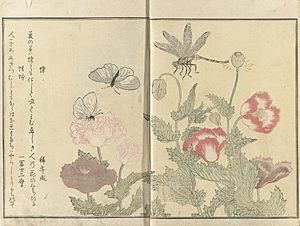Kitagawa Utamaro facts for kids
Quick facts for kids
Kitagawa Utamaro
|
|
|---|---|

Pink Flowers with Butterflies and a Dragonfly woodcut 1788
|
|
| Born |
Kitagawa Ichitarō
circa 1753 unknown
|
| Died | 31 October 1806 |
| Resting place | Senkōji |
| Nationality | Japanese |
| Style | Ukiyo-e |
Kitagawa Utamaro (born around 1753 – died October 31, 1806) was a famous Japanese artist. He is known for his amazing ukiyo-e woodblock prints and paintings. Utamaro is especially famous for his "large-headed pictures of beautiful women," called bijin ōkubi-e, which he made in the 1790s. He also created beautiful books about insects and nature.
Utamaro's Life and Art Journey
Not much is known about Utamaro's early life. His artwork started appearing in the 1770s. He became very popular in the early 1790s. This was when he began making portraits of women with unique, long features.
Utamaro created more than 2,000 known prints during his career. He was one of the few ukiyo-e artists who became famous all over Japan while he was still alive. At one point, he faced trouble with the authorities because of some of his prints.
Utamaro's Influence on Western Art
Utamaro's artwork arrived in Europe in the mid-1800s. It became very popular there, especially in France. His art had a big impact on European artists known as the Impressionists.
They were inspired by how he used partial views in his pictures. They also learned from his way of showing light and shadow. When people talk about "Japanese influence" on these artists, they often mean the work of Utamaro.
Images for kids
-
Ase o fuku onna (Woman Wiping Sweat), Ukiyo-e, 1798
-
Ukiyo-e of yama-uba with blackened teeth and Kintarō (Yamanba and Kintaro Sakazuki series)
-
Flowers of Edo: Young Woman's Narrative Chanting to the Shamisen c. 1803
-
Katō Kiyomasa at a party with Korean dancers
See also
 In Spanish: Utamaro para niños
In Spanish: Utamaro para niños

















